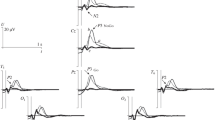The aim of the present work was to develop a Bayesian probabilistic model for parallel factor analysis of event-related potentials (ERP) in the human brain. Twelve statistical models considering the specific features of signals from ERP sources are proposed. Procedures for constructing sets of random parameter values based on Markov chain Monte Carlo methods were developed for these models. The effectiveness of these procedures was evaluated using both synthetic data with different signal:noise ratios and a set of ERP recordings obtained from 351 people in a Go/NoGo test. The procedure yielding the most accurate parameter assessments for models was selected. Analysis of the relationship between signals in the model and the type of activity performed by human subjects showed that Bayesian parallel factor analysis identifies functional differences between ERP components.
Similar content being viewed by others
References
Kropotov, Yu. D., Quantitative EEG, Cognitive Event-Related Potentials in the Human Brain, and Neurotherapy, Yu. A. Zaslavskii Press, Donetsk (2010).
Ponomarev, V. A. and Kropotov, Yu. D., “Clarification of the localization of sources of evoked potentials in the GO/NoGo test by modeling the structure of their mutual covariance,” Fiziol. Cheloveka, 39, No. 1, 36–50 (2013).
Ponomarev, V. A., Pronina, M. V., and Kropotov, Yu. D., “Parellel factor analysis in studies of event-related potentials” Fiziol. Cheloveka, 45, No. 3, 5–15 (2019a).
Ponomarev, V. A., Pronina, M. V., and Kropotov, Yu. D., “Cryptic components of event-related potentials in a visual Go/NoGo test with a warning stimulus,” Fiziol. Cheloveka, 45, No. 5, 20–29 (2019b).
Alquier, P. and Guedj, B., “An oracle inequality for quasibayesian nonnegative matrix factorization,” Math. Meth. Stat., 26, No. 1, 55–67 (2017).
Chen, X., He, Z., and Sun, L., “A Bayesian tensor decomposition approach for spatiotemporal traffic data imputation,” Transp. Res. Part C Emerg. Technol., 98, 73–84 (2019a).
Chen, X., He, Z., Chen, Y., et al., “Missing traffic data imputation and pattern discovery with a Bayesian augmented tensor factorization model,” Transp. Res. Part C Emerg. Technol., 104, 66–77 (2019b).
Chib, S., “Marginal likelihood from the Gibbs output,” J. Am. Stat. Assoc., 90, No. 432, 1313–1321 (1995).
Cichocki, A., Mandic, D., Phan, A.-H., et al., “Tensor decompositions for signal processing applications from two-way to multiway component analysis,” IEEE Signal Proc. Mag., 32, No. 2, 145–163 (2015).
Cong, F., Lin, Q. H., Kuang, L. D., et al., “Tensor decomposition of EEG signals: a brief review,” J. Neurosci. Meth., 248, 59–69 (2015).
Gelman, A., Carlin, J. B., Stern, H. S., et al., Bayesian Data Analysis, CRC Press, New York, London (2014), 3rd ed.
Hallez, H., Vanrumste, B., Grech, R., et al., “Review on solving the forward problem in EEG source analysis,” J. Neuroeng. Rehabil., 4, 46 (2007).
Koch, H. and Bopp, G. P., “Fast and exact simulation of multivariate normal and Wishart random variables with box constraints,” arXiv preprint, arXiv, 1907.00057 (2019).
Kolda, T. and Bader, B., “Tensor decompositions and applications,” SIAM Review, 51, No. 3, 455–500 (2009).
Kropotov, J. D. and Ponomarev, V. A., “Differentiation of neuronal operations in latent components of event-related potentials in delayed match-tosample tasks,” Psychophysiology, 52, No. 6, 826–838 (2015).
Kropotov, J., Ponomarev, V., Tereshchenko, E. P., et al., “Effect of aging on ERP components of cognitive control,” Front. Aging Neurosci., 8, 69 (2016).
Li, Y. and Ghosh, S. K., “Efficient sampling methods for truncated multivariate normal and student-t distributions subject to linear inequality constraints,” J. Stat. Theory Pract., 9, 712–732 (2015).
Luck, S. J. and Kappenman, E. S. (eds.), The Oxford Handbook of Event-Related Potential Components, Oxford University Press, Oxford: (2011).
Nakatsuji, M., Toda, H., Sawada, H., et al., “Semantic sensitive tensor factorization,” Artif. Intell., 230, 224–245 (2016).
Natarajan, R., Banerjee, A., and Shan, H., US Patent: US08818919, “Multiple imputation of missing data in multi-dimensional retail sales data sets via tensor factorization,” Aug. 26, 2014/13/204, 237.
Ponomarev, V. A., Mueller, A., Candrian, G., et al., “Group independent component analysis (gICA) and current source density (CSD) in the study of EEG in ADHD adult,” Clin. Neurophysiol., 125, No. 1, 83–97 (2014).
Press, W. H., Teukolsky, S. A., Vetterling, W. T., and Flannery, B. P., Numerical Recipes. The Art of Scientific Computing, Cambridge University Press, New York (2007), 3rd ed.
Salakhutdinov, R. and Mnih, A., “Bayesian probabilistic matrix factorization using Markov chain Monte Carlo,” in: Proc. 25th Int. Conf. on Machine Learning (2008), pp. 880–887.
Schmidt, M. N. and Mohamed, S., “Probabilistic non-negative tensor factorization using Markov chain Monte Carlo,” in: Proc. 17th Europ. Signal Processing Conf. (2009), pp. 1918–1922.
Smith, W. B. and Hocking, R. R., “Algorithm AS 53: Wishart variate generator,” J. R. Stat. Soc. Ser. C., 21, No. 3, 341–345 (1972).
Trinh, G. and Genz, A., “Bivariate conditioning approximations for multivariate normal probabilities,” Stat. Comput., 25, 989–996 (2015).
Xiong, L., Chen, X., Huang, T. K., et al., “Temporal collaborative filtering with Bayesian probabilistic tensor factorization,” in: Proc. 2010 SIAM Int. Conf. on Data Mining (2010), pp. 211–222.
Author information
Authors and Affiliations
Corresponding author
Additional information
Translated from Zhurnal Vysshei Nervnoi Deyatel’nosti imeni I. P. Pavlova, Vol. 70, No. 6, pp. 837–851, November–December, 2020.
Rights and permissions
About this article
Cite this article
Ponomarev, V.A., Kropotov, Y.D. Bayesian Parallel Factor Analysis for Studies of Event-Related Potentials. Neurosci Behav Physi 51, 882–892 (2021). https://doi.org/10.1007/s11055-021-01147-6
Received:
Revised:
Accepted:
Published:
Issue Date:
DOI: https://doi.org/10.1007/s11055-021-01147-6




